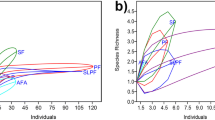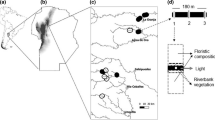Abstract
We examined species turnover in stream amphibians in rainforest in two hill ranges (Ashambu and Anamalai Hills) in the Western Ghats in south India. In each hill range, six stream segments (100 m in length) belonging to three drainage or rivers were surveyed three to four times in three seasons over 1 year. Species turnover (using 1-Sorenson's index) was estimated between all possible pairs of sites at three spatial scales – within drainage, between drainage and between hill ranges. Similar matrices were also developed for altitudinal difference and geographic distance between sites. A total of 30 species in four families were recorded from 3681 individuals. The hill ranges differed significantly in the composition of the stream community at both the species and family levels. Within the hill range, species turnover was correlated with altitudinal difference and not with geographic distance. Anamalai Hills had a greater species turnover than Ashambu Hills, both within and between drainage. There was also a high turnover between these two hill ranges, with only two shared species. This turnover explains the fact that only 30–40 species have been reported from different hill ranges, although regional diversity is high with about 130 species. The turnover also predicts that several undetected species should occur in hill ranges and drainage that have not been surveyed. The conservation model for mammals and birds, consisting of a few large protected areas, may not adequately address the conservation requirements of amphibians. Protection of rainforest frogs may require many protected areas in different drainages.
Similar content being viewed by others
References
Allmon W.D. (1991). A plot study of forest floor litter frogs, Central Amazon, Brazil. J. Trop. Ecol. 7: 503–522
Aravind N.A., Uma Shaanker R. and Ganeshiah K.N. (2004). Croak, croak, croak: are there more frogs to be discovered in the Western Ghats?. Current Sci. 86: 1471–1472
Biju (2001). A synopsis of the frog fauna of the Western Ghats, India. Occasional Publication of the Indian Society for Conservation Biology 1: 1–24
Bonnet E. and Van de Peer Y. (2002). zt: a Sofware tool for simple and partial mantel tests. J. Stat. Software 7(10).
Cincotta R.P., Wisnewski J. and Engelman R. (2000). Human population in the biodiversity hotspots. Nature 404: 990–992
Colwell R.K. 1997. EstimateS: Statistical estimation of species richness and shared species from samples. Version 5. User's Guide and application published at http://viceroy.eeb.uconn.edu/estimates.
Condit R., Pitman N., Chave J., Terborgh J., Foster R.B., Nunez P.V., Aguilar S., Valencia R., Villa G., Muller-Landau H.C., Losos E., Hubbell S.P. and Leigh E.G. (2002). Beta-diversity in tropical forest trees. Science 295: 666–669
Crist O.T., Veech J.A., Gering J.C. and Summerville K.S. (2003). Partitioning species diversity across landscapes and regions: a hierarchical analysis of α, β, and γ diversity. Am. Nat. 162(6): 734–743
Daniels R.J.R. (1992). Geographical distribution patterns of amphibians in the Western Ghats, India. J. Biogeogr. 19: 521–529
Duellman W.E. (1988). Patterns of species diversity in anuran amphibians in the American tropics. Ann. Missouri Bot. Garden 75: 79–104
Duellman W.E. (1999). Global distribution of amphibians: patterns, conservation and future challenges. In: Duellman, W.E. (eds) Patterns of Distribution of Amphibians: A Global Perspective, pp 1–30. The John Hopkins University Press, Baltimore
Easa P.S. (1998). Survey of Reptiles and Amphibians in Kerala part of Nilgiri Biosphere Reserve. Kerala Forest Research Institute, Kerala, India
Harte J., McCarthy S., Taylor K., Kinzig A. and Fischer M.L. (1999). Estimating species-area relationships from plot to landscape scale using species spatial-turnover data. Oikos 86: 45–54
Hubbell S.P. (2001). The Unified Neutral Theory of Biodiversity and Biogeography. Princeton University Press, Princeton, NJ
Inger R.F. (1999). Distribution of amphibians in Southern Asia and adjacent islands. In: Duellman, W.E. (eds) Patterns of Distribution of Amphibians: A Global Perspective, pp 445–481. The John Hopkins University Press, Baltimore
Inger R.F. and Stuebing R.B. (1992). The montane amphibian fauna of northwestern Borneo. Malayan Nature J. 46: 41–51
Inger R.F., Shaffer H.B., Koshy M. and Bakde R. (1987). Ecological structure of a herpetological assemblage in South India. Amphibia–Reptilia 8: 189–202
Johnsingh A.J.T. (2001). The Kalakad–Mundanthurai tiger reserve: a global heritage of biological diversity. Current Sci. 80: 378–388
Krishnamurthy S.V. (1999). Amphibian diversity in a few selected environs of Western Ghats. In: Hussain, S.A. and Achar, K.P. (eds) Biodiversity of Western Ghats complex of Karnataka, pp. Biodiversity Initiative Trust, Mangalore, India
Pascal J.P. (1988). Wet evergreen forests of the Western Ghats of India: ecology, structurefloristic composition and succession. Institut de Français, Pondichéry, Travaux de la section Scientifique et technique, Pondicherry, India, xx bis 345
Tuomisto H., Ruokolainen K. and Yli-Halla M. (2003). Dispersal, environment and floristic variation of Western Amazonian Forests. Science 299: 241–244
Vasudevan K. (2000). Amphibian Species Assemblages of the Wet Evergreen Forests of Southern Western Ghats of India and the Effect of Forest fragmentation on their diversity. Ph.D. thesis, Utkal University, Bhubaneshwar, ix + 115 pp + vi appendices.
Veech J.A., Summerville K.S., Crist T.O. and Gering J.C. (2002). The additive partitioning of species diversity: recent revival of an old idea. Oikos 99: 3–9
Voris H.K. and Inger R.F. (1995). Frog abundance along streams in Bornean forests. Conserv. Biol. 9: 679–683
Wolda H. (1981). Similarity indices, sample size and diversity. Oecologia 50: 296–302
Whittaker R.H. (1960). Vegetation of the Siskiyou Mountains, Oregon and California. Ecol. Monogr. 30: 279–338
Author information
Authors and Affiliations
Corresponding author
Rights and permissions
About this article
Cite this article
Vasudevan, K., Kumar, A. & Chellam, R. Species turnover: the case of stream amphibians of rainforests in the Western Ghats, southern India. Biodivers Conserv 15, 3515–3525 (2006). https://doi.org/10.1007/s10531-004-3101-x
Received:
Accepted:
Published:
Issue Date:
DOI: https://doi.org/10.1007/s10531-004-3101-x




